|
|
|
Sort Order |
|
|
|
Items / Page
|
|
|
|
|
|
|
| Srl | Item |
| 1 |
ID:
133127
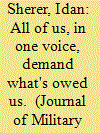

|
|
|
|
|
| Publication |
2014.
|
| Summary/Abstract |
This article examines the main characteristics of mutinies in the Spanish tercios at the height of the Italian Wars (1494-1559), a surprisingly under-researched subject considering the high frequency of such upheavals in these core infantry units. Contrary to the severe legal and moral implications of modern military mutinies the dynamics of the mutinies in the tercios resembled more closely those of a modern workers' strike, in that the soldiers were allowed room to organize, make representations, negotiate and reach relatively amicable conclusions. Generals and soldiers alike accepted the recurring mutinies as a way of maintaining the organizational status quo in a context of infrequent paydays and persistent supply problems.
|
|
|
|
|
|
|
|
|
|
|
|
|
|
|
|
| 2 |
ID:
133130
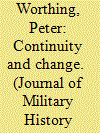

|
|
|
|
|
| Publication |
2014.
|
| Summary/Abstract |
This article analyzes the Chinese Nationalist Army at the tactical level, examining how the Nationalists deployed and employed forces to achieve victory from the earliest battles in 1925 to the first stage of the war against the Japanese in 1937-1938. It argues that certain "core characteristics" of the Nationalist Army shaped its tactics in a way that maximized its strengths and minimized its weaknesses, producing a number of important victories from 1925 to 1930. Importantly, the year 1930 marked a key turning point as new enemies and conditions led the Nationalists away from the successful tactics of the 1920s, contributing to the weaker record of the 1930s.'
|
|
|
|
|
|
|
|
|
|
|
|
|
|
|
|
| 3 |
ID:
133131


|
|
|
|
|
| Publication |
2014.
|
| Summary/Abstract |
One of the accepted orthodoxies about the Greek Civil War (1946-49) is that the Greek government's eventual victory was achieved only because of Anglo-American training and equipment. This article argues that the Greek National Army developed its own military strategy, and that advice from British or American advisory teams was often disregarded, especially during the final years of the conflict. The Greek National Army learned while fighting, and devised what would be recognised today as a "clear, hold, build" strategy. The learning curve was steep, against a Communist opponent who was ruthless and well equipped.
|
|
|
|
|
|
|
|
|
|
|
|
|
|
|
|
| 4 |
ID:
133129
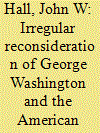

|
|
|
|
|
| Publication |
2014.
|
| Summary/Abstract |
By synthesizing recent works on early American warfare and biographies of George Washington with his own writings, this essay attempts to reconcile divergent interpretations of Washington as a paragon of frontier martial virtue, a pedant for European orthodoxy, a genius, and a stumblebum. The officer who emerges is a martial cosmopolitan; the forces he constructed and the strategy by which he employed them were the hybrid products of his own experience on the American frontier and European precedents for both grande and petite guerre. Ultimately, they served his nation's dearest interests: independence and territorial expansion at the expense of American Indians.
|
|
|
|
|
|
|
|
|
|
|
|
|
|
|
|
| 5 |
ID:
133132
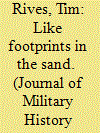

|
|
|
|
|
| Publication |
2014.
|
| Summary/Abstract |
Given the importance of General Dwight D. Eisenhower's decision to launch the invasion of Normandy on 6 June 1944, both to the outcome of the war and to him personally, it is mysterious that neither he nor the commanders who witnessed his supreme moment could agree on what he said when he set the Allied force in motion. While the fog of war explains some of the discrepancies in the eyewitness accounts, Eisenhower's modest character also plays a role in the mystery. Seventy years later, we still do not know what words unleashed the Allied assault on the Atlantic Wall.
|
|
|
|
|
|
|
|
|
|
|
|
|
|
|
|
| 6 |
ID:
133128
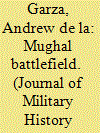

|
|
|
|
|
| Publication |
2014.
|
| Summary/Abstract |
Although the Mughal Empire was one of the great powers of the Early Modern world, surprisingly few studies of the Empire address its military history. Those that do tend to treat Mughal military practice, and that of the Muslim world in general, as an "inferior control sample" for the successful experiments of the European Military Revolution. As this essay on the practical aspects of Mughal warfare will demonstrate, however, South Asia during this era was far from deficient in military technology and organization. It was, rather, a nexus of innovation and achievement.
|
|
|
|
|
|
|
|
|
|
|
|
|
|
|
|
| 7 |
ID:
133133
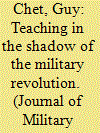

|
|
|
|
|
| Publication |
2014.
|
| Summary/Abstract |
In recent years, policy makers have noted that western armies in foreign lands l find themselves tasked with a new form of warfare. 'we'he novelty of twenty-f1rst Century warfare is usually traced to armies' non-combat tasks, such as civil and military engineering, economic development and security, crowd control, policing, community engagement, and public relations. Yet scholars of early modern are widely recognized these elements as central to the wars they examine, d thus not novel at all. Since specialists in the field examine armies engaged I dominantly in such non-combat activities, it is worth asking why similarities cen early modern and contemporary warfare are routinely overlooked. One _n is that despite rese-archers' increasing focus on the more mundane aspects strategy history, undergraduate classes retain the more traditional military history of battles and "Great Captains." In sections dealing with early modem ,for example, students get diplomacy, logistics, engineering, economics, social propaganda, and social control only in small doses, signifying to them that were less prevalent and less signi?cant than major battles in determining curse of wars and military affairs.
|
|
|
|
|
|
|
|
|
|
|
|
|
|
|
|
|
|
|
|
|